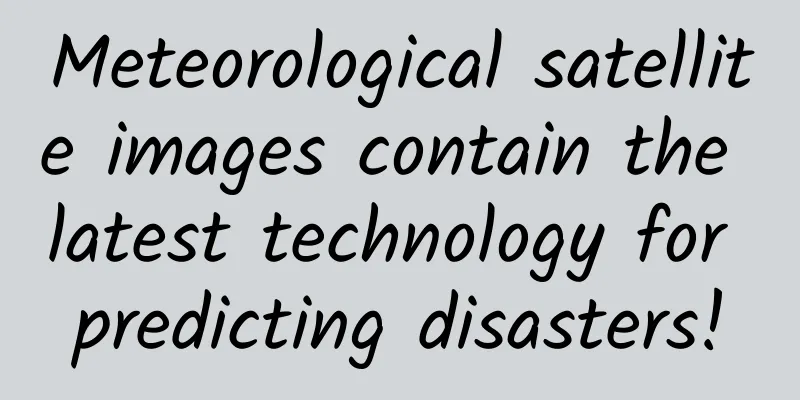Meteorological satellite images contain the latest technology for predicting disasters!

|
Not long ago, typhoons Dusurui and Kanu hit one after another, causing great casualties and property losses. In the face of disasters such as typhoons, imagine the following two situations: A: You can use your mobile phone, television, etc. to know at any time where the typhoon is and where it may go next, so you can prepare supplies early and do a good job of disaster prevention. B: I only know that there are typhoons in this season, and I make this judgment based on experience. Copyright images in the gallery. Reprinting and using them may lead to copyright disputes. I believe everyone will choose A, right? Yes, just as important as disaster relief is the continuous monitoring and tracking of the weather, making accurate judgments, and issuing warnings in a timely manner. So, where does our weather data come from? A large part of the weather data comes from meteorological satellites in the sky. Let's take a look at meteorological satellites and their basic working principles! Physical foundation: remote sensing The working principle of meteorological satellites is remote sensing, which means "distant perception" as the name suggests - only looking but not touching, using non-contact means to detect the various properties of objects. Although it sounds very high-tech, remote sensing is actually a basic function of each of us. For example, when we are walking on the road, we suddenly hear footsteps behind us. When we turn around, it is Xiao Li! This is the remote sensing ability of the ears and eyes. However, if we raise the difficulty of the problem a little, our natural remote sensing skills will not be enough. For example, is the white shirt that Xiao Li is wearing today made of pure cotton, silk or chemical fiber? You can only find out by twisting it with your hands, but if you stretch out your hands, it becomes contact detection, not remote sensing. What should we do? We can ask for help from instruments to observe the reflectance spectrum of Xiao Li’s clothes. What does this word mean? When light shines on an object, some wavelengths (colors) of light will be absorbed and some will be reflected. When we shine it with different wavelengths, we will see different brightness. Plotting the curve of brightness versus wavelength is the reflection spectrum. For example, leaves absorb red and blue light and reflect green light. The green we see is the general reflection spectrum of leaves. With the help of instruments, this spectrum can be more refined and specific to wavelength. If we observe Xiao Li's white shirt in the infrared band, different materials will show different infrared spectra, and we don't have to twist it manually. In addition, all objects radiate electromagnetic waves. Cold objects have longer wavelengths, hot objects have shorter wavelengths, and they will show a characteristic spectral distribution depending on the composition of the material. Therefore, by observing the radiation spectrum of an object, its composition and temperature can be determined. For example, the mobile phone in front of you, each "white" image point actually has only three colors, red, green and blue, while real sunlight has everything from red to purple. Micrograph of an LCD screen. Each pixel is made up of a combination of red, green and blue. Now that we understand the basic principles of remote sensing, let’s take a look at how meteorological satellites do it. What do weather satellites see? Let's design a weather satellite. What would we ask it to see? How would we ask it to see? Since it is a meteorological satellite, it must at least be able to capture common visible light satellite cloud images. This is the most intuitive representation of the weather. We can see the distribution and thickness of the clouds. If we continue to observe, we can also see the flow of clouds. These are data that the general public can understand and even analyze, so they are necessary and relatively easy to implement. However, visible light alone is not enough. At night, one side of the earth is in darkness, and the clouds cannot be seen clearly with the naked eye. Therefore, in order to monitor the weather continuously for 24 hours, we need to add night vision function. As we said before, all objects emit radiation. If we observe in the infrared or even microwave band, we can see the clouds clearly at night. Cloud map taken by Fengyun 4A, the left is the night view, the right is the day view It seems simple enough! But let's go a little deeper. Can we trust what satellites see? Why can't the clouds they see be snow on the ground? How can we distinguish them from volcanic ash from volcanoes? Why can't the bright clouds we see at night be city lights? Therefore, the remote sensing principle mentioned earlier is used here. By using the "eyes" of scientific instruments to perform spectral analysis, we can not only see the color of an object, but also know its true temperature and composition. Of course, in reality, whether it is visible light or infrared, satellites observe complex superposition signals. For example, the clouds seen during the day are composed of the sunlight reflected by the clouds, the radiation emitted by the clouds themselves, and the background radiation from the earth and the atmosphere. This requires professionals to design special algorithms to separate these three signals one by one to obtain accurate information. The clouds and atmosphere observed by satellites not only have image outlines, but also detailed information such as temperature and humidity, altitude distribution, composition, lightning and thunderstorms, etc. After the data observed by meteorological satellites are sent back to the ground, they are taken over by supercomputers and forecasts are made using numerical models. The strange dance of Typhoon Kanu is the result of being squeezed by three high-pressure anticyclones. In the end, Kanu's path was consistent with the forecast, which is the result of the cooperation between the precise observations of meteorological satellites and the numerical models of supercomputers. Are meteorological satellites only used to predict the weather? The basic principles of meteorological satellites determine that we can broaden our horizons and use meteorological satellites to study many interesting things. For example, we can monitor agriculture through meteorological satellites. The temperature and water content of the soil can be reflected in the spectrum, and the reflection spectrum of vegetation to light can reflect chlorophyll, cell structure and water content at different wavelengths. Different crops have their own reflection spectra. Through satellite remote sensing, we can judge the soil condition, crop type, crop growth, and whether there are diseases and insect pests. Our "Fengyun" meteorological satellites have agricultural monitoring functions. In addition to observing clouds and weather, they are also the guardians of agriculture. We can also use meteorological satellites to monitor atmospheric carbon content. When ground radiation passes through the atmosphere to the satellite, some wavelengths will be absorbed by carbon dioxide. By analyzing the absorption spectrum, we can understand the atmospheric carbon content around the world, providing a scientific basis for energy conservation and emission reduction, and setting carbon emission targets scientifically and rationally. The carbon satellite "Jumang" launched by China in 2022 is for this purpose. Going further, spectral analysis can not only be used on meteorological satellites, but we can also use spectral analysis to study the universe and observe and study the weather of other planets . Spacecraft with this function can be regarded as "cosmic meteorological satellites" to some extent. For example, this photo of Neptune taken by the Webb Space Telescope. Triton in the upper left corner seems to completely overwhelm the brightness of Neptune and would almost be mistaken for a star. This is because the Webb telescope observes in the infrared band. There is abundant water ice on the surface of Triton, which has a high albedo for sunlight (including infrared rays), while the methane component in Neptune's atmosphere can absorb infrared rays, so the overall color becomes darker. The bright strips and spots on the surface of Neptune are highly reflective areas of ice composed of methane and water. Their distribution outlines the storms on Neptune. Triton and Neptune. Copyright image. Reprinting and using may cause copyright disputes. To sum up, meteorological satellites mainly rely on remote sensing technology to obtain various meteorological data, and the remote sensing capabilities of meteorological satellites also allow them to not only help forecast the weather, but also provide more help. Finally, I would like to remind everyone again that when you see various weather warnings, you must be prepared in time for disaster prevention and mitigation! Planning and production Author: Qu Jiong, popular science creator Review丨Yang Lei, Deputy Chief Engineer of Fengyun-4, National Satellite Meteorological Center Planning丨Ding Zong Editor: Yinuo The cover image and the images in this article are from the copyright library Reprinting may lead to copyright disputes |
<<: Are the popular plant-based foods just a waste of money or are they really good for your health?
>>: She used her "special abilities" to help scientists decipher the early signs of disease
Recommend
It is one of the most dangerous birds in the world, but it has been kept in captivity.
Today we are going to talk about a bird, a beauti...
The most effective user growth methodology!
Isn’t the value of the product what makes users b...
Full-network marketing, one marketing matrix can do it all!
Concepts in the marketing field are different fro...
Promotion case in circle of friends in tourism industry!
This article shares with you a case study of WeCh...
Has the new media dividend passed? You don’t know how to spread content!
We often say that the bonus period of WeChat new ...
up to date! Traffic rankings of 45 information flow platforms across the entire network!
The latest traffic rankings of major information ...
How to do online promotion and marketing? Sharing Internet promotion skills!
With the development of the Internet, mobile netw...
Southern Ox Year Fortune Cracked Version, Southern Ox Year Fortune 2020 Cracked Version
The Southern Ox Year Fortune 2021 is a fortune pr...
A brief analysis of the content marketing strategy of Li Ziqi, the “first internet celebrity with ancient style”!
• Introduction• Explore the value behind the IP o...
2014 Smart Routers and TV Boxes: One is a Minor and the Other is a Half-Disabled
With the popularity of the smart home concept, to...
What solutions does AWE2024 provide for the most serious pain points in household cleaning?
Household cleaning has become a habit in our mode...
The price was cut in half in just one month. Has the Bitcoin bubble really burst?
According to Reuters, on Wednesday, the price of ...
Tesla, Toyota and more than 100 other car manufacturers' secrets leaked, with 157 GB of core secrets leaked
According to the New York Times, security researc...
It is a disease, but we have seriously ignored it...
There is a disease, You may not know it is a dise...









